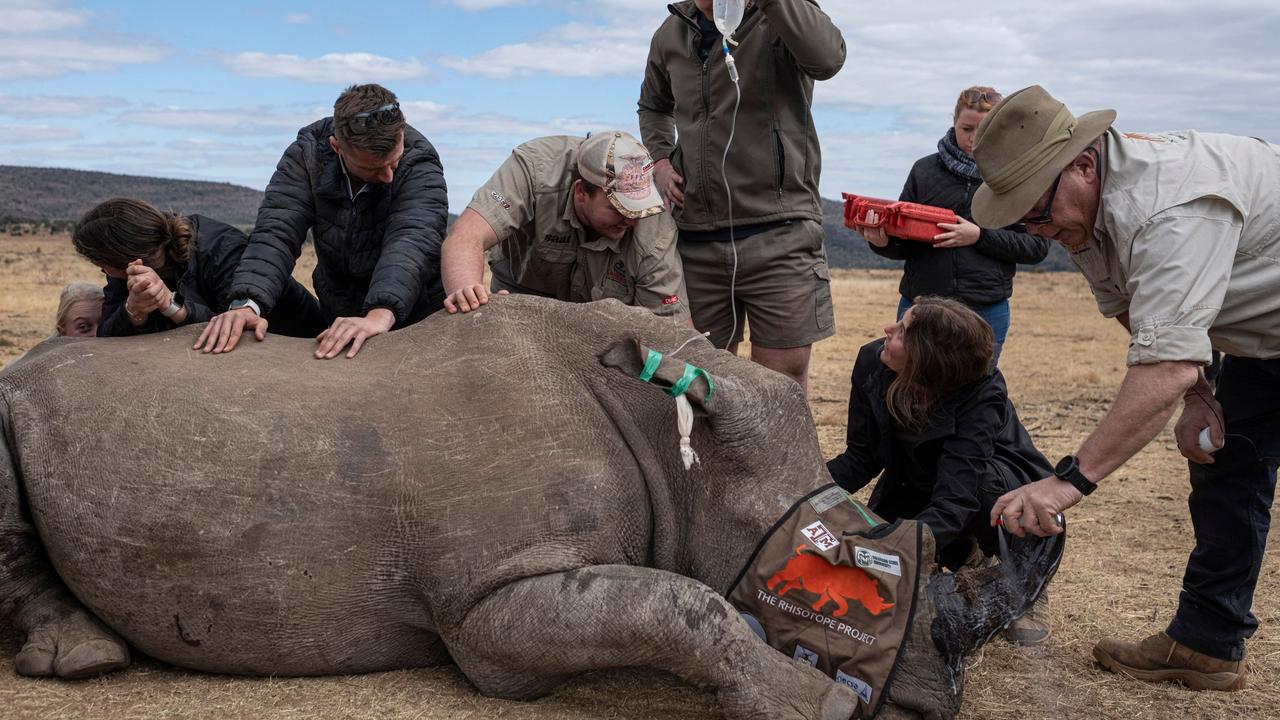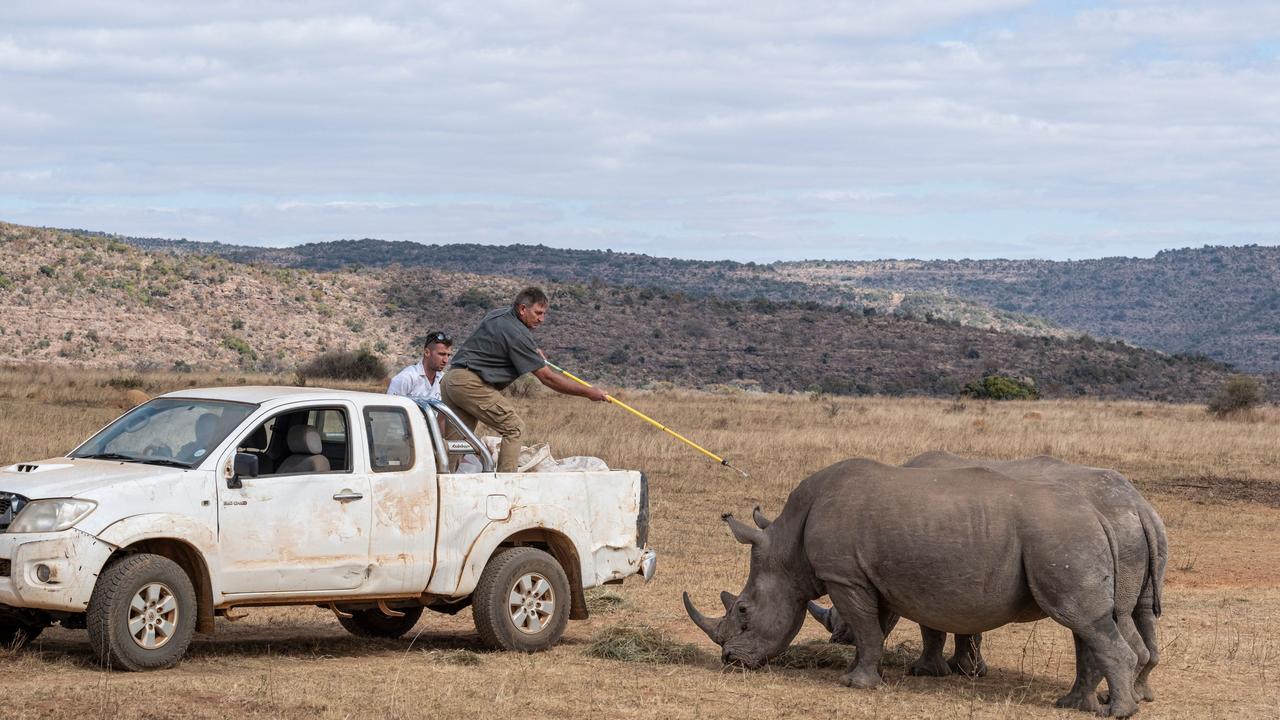A new battle to save the rhinos by making them radioactive
Scientists in South Africa are injecting radioactive chips into rhino horns to make animals 'useless' to illegal poachers

READING LEVEL: ORANGE
Scientists in South Africa have injected* radioactive material* into live rhino horns to make them easier to detect at border posts* in a project aimed at curbing* poaching*.
The country is home to a large majority of the world’s rhinos and as such is a hotspot for poaching driven by demand from Asia, where horns are used in traditional medicine*.
James Larkin, director of the University of the Witwatersrand’s radiation and health physics unit who spearheaded* the initiative, said he had put “two tiny little radioactive chips* in the horn” of the large animals.

The radioactive material would “render* the horn useless … essentially poisonous for human consumption*” added Nithaya Chetty, professor and dean of science at the same university.
The radioactive material’s dose was so low it would not impact the animal’s health or the environment in any way, he said.
In February the environment ministry said that, despite government efforts to tackle the illicit* trade, 499 of the giant mammals were killed in 2023, mostly in state-run parks. This represents an 11 per cent increase over the 2022 figures.
Twenty live rhinos in total would be part of this pilot project* whereby they would be administered* a dose “strong enough to set off detectors that are installed globally” at international border posts.

Border agents often have handheld radiation detectors which can detect contraband* in addition to thousands of radiation detectors installed at ports and airports, the scientists said.
Rhino horns are highly sought after on black markets*, where the price by weight rivals that of gold.
According to Arrie Van Deventer, a rhino orphanage founder in South Africa, dehorning the rhino and poisoning the horns have failed to deter poachers.
“Maybe this is the thing that will stop poaching”, she said. “This is the best idea I’ve ever heard”.

About 15,000 rhinos live in South Africa, according to an estimate by the international Rhino foundation.
The team would then take follow-up blood samples to ensure the rhinos were effectively protected.
The material would last five years on the horn, which was cheaper than dehorning* every 18 months.
GLOSSARY
- injected: introduced a substance into something else, often using a syringe or similar device
- radioactive material: substances that emit radiation, often used in medical treatments and scientific research
- border posts: checkpoints at the boundaries of countries where goods and people are inspected
- curbing: limiting or controlling something undesirable
- poaching: illegal hunting or capturing of wild animals
- traditional medicine: healing practices and beliefs that have been used historically in various cultures, often involving natural remedies
- spearheaded: led or initiated a project or initiative
- radioactive chips: small devices containing radioactive material
- render: to cause something to be in a particular condition
- human consumption: the act of eating, drinking, or using something by people
- illicit: illegal trade and activities
- pilot project: a small-scale preliminary study conducted to evaluate feasibility, duration, cost, and adverse events
- administered: given or applied (often in a medical way)
- contraband: goods that have been imported or exported illegally
- black markets: illegal trading environments where goods and services are exchanged without government regulation
- dehorning: the process of removing the horns of an animal, often to protect it from poachers
- deterrent: something that discourages or is intended to discourage someone from doing something
EXTRA READING
Taking selfies with endangered mountain gorillas
Zoo welcomes southern white rhino calf
QUICK QUIZ
- What is the purpose of injecting radioactive material into rhino horns in South Africa?
- Who is James Larkin and what role did he play in this project?
- How will the radioactive material affect the rhino horns and poaching?
- How long will the radioactive material last on the rhino horns?
- What was the reported increase in the number of rhinos killed from 2022 to 2023?
LISTEN TO THIS STORY
CLASSROOM ACTIVITIES
1. Radioactive rhinos
While this new experiment to stop poachers can get them in serious trouble if caught with rhino horns injected with this radioactive material at border crossings, how will poachers visibly be able to see those that are injected with the material?
Work with a partner and come up with a way to mark rhinos as being ‘radioactive’ to deter poachers from killing them.
Outline or sketch your marking or symbol below:
Could this marking be applied to all rhinos in the state-run park, even if they aren’t part of the trial to deter poachers?
Time: allow 20 minutes to complete this activity
Curriculum Links: English, Science, Personal and Social, Critical and Creative Thinking
2. Extension
Since rhino horns are so in demand in Asian countries, think of a way that the authorities in South Africa or the conservation authorities can legally get the ingredients in demand from the rhino horns, bottle them and sell them legally.
Create your bottle, label and name the product for sale. All money made can go back into rhino conservation.
Time: allow 20 minutes to complete this activity
Curriculum Links: English, Science, Personal and Social, Critical and Creative Thinking
VCOP ACTIVITY
Summarise the article
A summary can be a really good way to grab the main idea plus some key points in the article as a highlight. Think of the summary like a little advertisement or extract you could use to encourage people to read the article in detail. You want to give them an overview of the article that includes the main idea (being able to tell the audience what the article is about in one sentence), plus a few of the key points of the information.
Remember to re-read your summary to check that it is clear, concise and makes sense to the audience who haven’t read the article yet. You need to make language choices that allow you to explain the information in only a few sentences.

